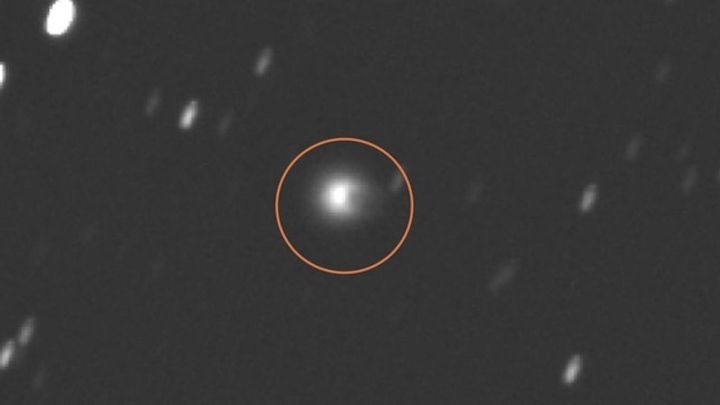An unusual volcanic comet hurtling toward the Sun appears to have grown a horn after exploding, causing it to shine like a tiny star and spew supercooled magma into space. It is the first time the comet has erupted in nearly 70 years.
The comet, designated 12P/Pons-Brooks (12P), is a cryogenic comet. Like all comets, the icy object is made up of a solid nucleus filled with a mixture of ice, dust, and gas, and surrounded by a hazy cloud of gas that escapes from the comet's interior.

Image 12P (circled) was taken on July 24. (Photo: Thomas Wildoner/The Dark Side Observatory).
Unlike most other comets, however, the gas and ice inside 12P's core has accumulated so much that the object can explode violently, shooting out its icy guts, called cryomagma, through large cracks in the core's shell.
On July 20, astronomers spotted a huge explosion from the comet. It suddenly became about 100 times brighter than usual, Spaceweather.com reported.
Comet Inflates Abnormally
This increase in brightness occurs when the comet suddenly swells with gas and ice crystals released from inside the comet, allowing it to reflect more sunlight back to Earth.
As of July 26, the comet's trail had grown to 230,000 kilometers (7,000 times wider than its nucleus) and had an estimated diameter of about 30 kilometers (19 miles), said Richard Miles, an astronomer at the British Astronomical Association who studies cryovolcanic comets.
But interestingly, an anomaly in the shape of the expanding trail makes the comet look as if it has grown horns. Other experts have also likened the comet to being deformed.
The unusual shape of the comet's trail may be due to an irregular shape of the 12P nucleus, Miles said. The escaping gas is likely partially obstructed by a protruding lobe on the nucleus.
This is the first major eruption detected from 12P in 69 years, Miles said, largely because its orbit takes it too far from Earth to notice its eruptions.
12P has one of the longest known orbital periods of any comet. It takes about 71 years for the comet to completely orbit the Sun, during which time it is the furthest it has been ejected into the Solar System.
Volcanic comet
The comet will reach its closest point to the sun on April 21, 2024, and its closest approach to Earth will be on June 2, 2024, at which point it will be visible in the night sky, Spaceweather.com reported. So Earthlings could be in a position to see more eruptions in the next few years.
However, 12P isn't the only volcanic comet researchers are keeping an eye on right now. Over the past few years, there have been a number of notable eruptions from 29P/Schwassmann-Wachmann (29P) - the most volatile volcanic comet in the Solar System.
In December 2022, astronomers witnessed the largest eruption from 29P in about 12 years, spewing about 1 million tons of cryomagma into space.
And in April this year, scientists were able to accurately predict one of 29P’s eruptions for the first time before it actually happened, thanks to a slight increase in brightness that suggested more gas was leaking out of the comet’s nucleus as it prepared to erupt.
(Source: Tien Phong)
Useful
Emotion
Creative
Unique
Wrath
Source






























































































![[Infographic] In 2025, 47 products will achieve national OCOP](https://vphoto.vietnam.vn/thumb/402x226/vietnam/resource/IMAGE/2025/7/16/5d672398b0744db3ab920e05db8e5b7d)





Comment (0)